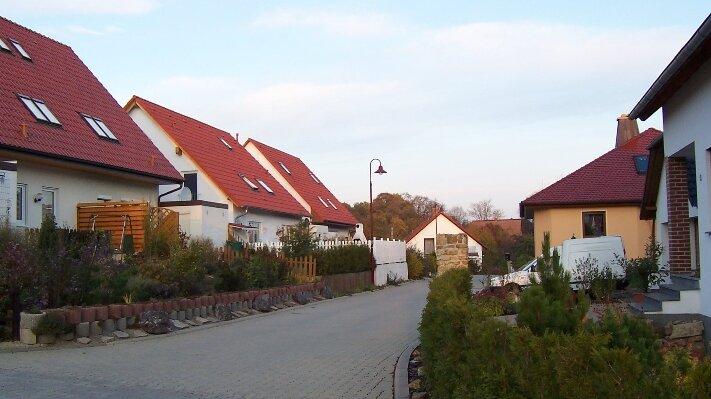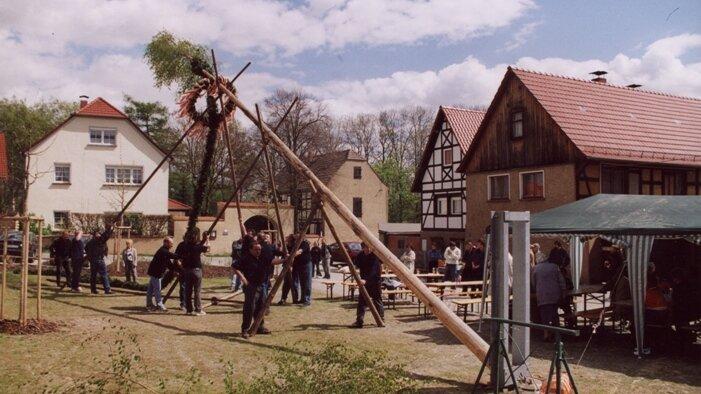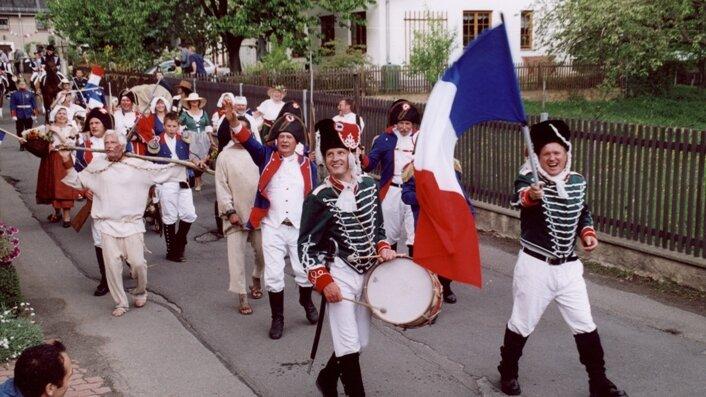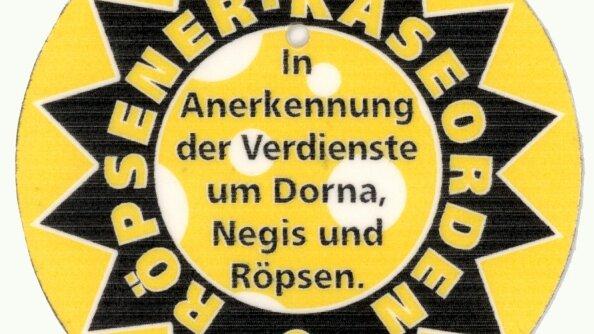District Röpsen
Data and facts:
| Name of the district: | Röpsen |
| with the localities: | Röpsen, Dorna, Negis |
| District of the city of Gera since: | 01.04.1994 |
| Surface area: | 819 h |
| Population: (as at: 31.12.2022) | 603 |
Location and transport connections
| Location: | Röpsen with the villages of Negis and Dorna is located in the north-eastern part of the town. The district lies in the charming river landscape of the Brahme, the Negisbach and the Hainbach and is embedded in meadows and fields. The villages have historic settlement centers with an agricultural character, many old farmhouses and farmsteads and an old stock of trees. |
| Utilization: | The existing, established villages have a strong village character and reflect the historical combination of agricultural and residential use in terms of design. The importance of agriculture as an employer has declined significantly. The arable land is farmed by the Cretzschwitz agricultural cooperative. Small craft and service businesses are located here. |
| Landscape and site design: | The eastern part of Röpsen is a morphologically varied area. The landscape is characterized by fields and meadows. The integration of the established villages into the landscape is given due to the strong greening with trees and shrubs typical of the landscape. The street structure is village-like. The Brahmeaue is a habitat area for the "hermit", which is on the Red List. This is a rare beetle that is unable to fly. The "limestone quarry" in Dorna and the "Speudewitz Castle" near Röpsen are natural monuments. There is an extensive network of hiking trails in and around Röpsen. The following special features can be found in Röpsen: old farm gardens, orchards, near-natural forests, floodplains, terraced fields, standing and flowing waters, the Röpsen quarry, pollarded trees on the Brahme, the Dorna redoubt, the gymnastic oak in Röpsen, the Napoleon meadow in Dorna and striking churches in Dorna and Röpsen. |
| Transport connections: | Röpsen can be reached via the L 1079 or the L 1079n. Internal access is via municipal roads. Röpsen, Dorna and Negis can be reached by public transport via bus line 27 of GVB GmbH and twice on school days with line 235 of RVG GmbH. |
History
History of Röpsen
Author: W. Hartick, district mayor
In 1952, the previously independent villages of Röpsen, Dorna and Negis merged to form the municipality of Röpsen. In the summer of 1994, Röpsen was incorporated as a district of Gera.
We would like to briefly introduce our district below:
The district of Röpsen is centrally located in the idyllic lower Brahmetal valley. The three villages of Röpsen, Dorna and Negis are each about 1.5 kilometers apart. The location is very convenient in terms of transport: the villages are around nine kilometers from Gera city center. The connection to the B2 towards Zeitz is one kilometer away, and the Gera junction on the B9 freeway is one kilometer away.
Situated in the charming landscape of the Brahme, Negisbach and Hainbach rivers, nestled between meadows, fields and forests, Röpsen, Dorna and Negis have experienced a very varied history. Two historically valuable churches and many old farmsteads are eloquent testimonies to times gone by.
The district of Röpsen currently has 642 inhabitants, 245 of whom live in the village of Röpsen, 322 in Dorna and 75 in Negis. In contrast to the generally declining population trend, the district of Röpsen has largely maintained its population over the decades. The main reason for this pleasing development is the new development area "Am Baumgarten" in Dorna, which was created after 1994 with 45 new houses and 103 residents.
During the last 25 years "in the bosom of the city of Gera", many new things have been created in all three villages. Almost all citizens have lent a hand in beautifying their buildings and properties. A total of three new bridges were built. The village square in Röpsen was completely redesigned and is now a real gem. It is now just as suitable as a meeting place for the local population as it is for the annual maypole planting or a small Christmas market. In particular, the lovingly designed fountain with the wooden bears standing next to it is a feast for the eyes.
The diverse farm gardens and orchards have been properly maintained and cared for. The Brahme floodplain has also been preserved as a specially protected biotope. Near-natural forests, floodplains, terraced fields, standing and flowing waters, the Röpsen quarry, the pollarded trees on the Brahme, the Dorna ski jump and the gymnastic oak in Röpsen make up the beauty of our homeland.
The Steinberg, popularly known as the Galgenberg, is an example of early German land division with its peculiar field layout. One narrow strip of field lies next to another, separated by ravines.
The redoubt above Dorna is the remains of a small castle from the early Middle Ages. Centuries ago, the Speutewitz castle and the village of the same name stood on Röpsener Flur. Today, only a mountain spur is still visible at the site. The village has been deserted for 500 years.
Many legends surround the villages and bear witness to an eventful past.
A specially protected area (habitat area) is located on the banks of the Brahme. A very rare, flightless beetle lives here in one of its last retreats: the hermit beetle. It lives in the wood of old trees, feeds on them and also reproduces there.
In the competition "Our village should become more beautiful, our village has a future", the village took an excellent third place in 2011 against strong competition from the district of Greiz. In particular, the lively club life and the cooperation of the village population in many projects were highlighted as positive in the evaluation. Around half of the population in Röpsen is involved in 7 clubs. Major associations include the Röpsen-Dorna-Negis local history association and the Dorna-Negis volunteer fire department support association.
In addition to many other activities, the local history association has been publishing a quarterly twelve-page "Heimatbote" with stories from the past and the latest local news since 1997 and distributes it free of charge to residents. Anyone who has collected all of the more than 100 issues published to date already has a small local chronicle. You can read all the issues on the Internet at www.gera-dorna.de.
In addition to its fire-fighting and rescue activities, the Dorna fire department also plays an active part in village life by organizing the annual maypole ceremony and folk festival in Dorna. A maypole is also erected in Röpsen by the local heritage association and in Negis by the residents. The Dorna Poultry Breeders' Association, the Rabbit Breeders' Association, the Loam Construction Association and the Röpsen School Support Association are also very well known. The Brahmetaler Posaunenchor Röpsen plays during church services and celebrations.
The district council plays an important organizing and mediating role. Over the past 25 years, it has initiated a large number of projects and measures or called on the city of Gera to implement them.
Our citizens not only know how to work, but also how to celebrate big events. For example, Röpsen and Negis celebrated their 900th anniversary in 2021 with a grand festival weekend. A chronicle about the houses in Röpsen was created.
Despite their proximity to the town of Gera, all three villages were able to retain their village character. Despite this, however, there are still clear differences between the three closely situated villages: Röpsen belonged to the Duchy of Altenburg within a small enclave until 1918, while Dorna and Negis were governed by the Principality of Reuß j.L. Gera.
In the following, we would like to present the characteristics and special features of the three individual villages:
Röpsen
For many years, Röpsen was the largest village within the district of the same name. Situated directly on the Hainbach and Brahme rivers, Röpsen, like almost all the villages in our area, was founded by the Sorbians. It was first mentioned in documents in 1121 as Rupizan.
The face of the village is characterized by many farms. They used to be family farms. In order to ensure the survival of the families, additional sources of income often had to be found.
The village became famous for its production of cheese sticks. They earned the village the name "Käse-Röpsen". The cheesemakers bought the curd from the farmers in the surrounding villages and processed it into cheese. In 1938, there were 10 cheese dairies in Röpsen. The state compulsion to deliver the milk to the dairy farm was the downfall of the cheese dairies. But the memory remains.
Porcelain painting also played an important role until the economic crisis in 1924. In particular, the painting of porcelain pipe bowls fired in Roschütz was widespread. The basket-making trade was also practiced intensively.
A lot has happened in Röpsen since it was incorporated in 1994:
The Trinitatis church, which dates back to 1669, was reconsecrated in December 1997 after seven years of construction. A strong church community ensured that the renovation work did not stop, organized fundraising and help The local history association erected a memorial to the fallen of the Second World War next to the church.
The Röpsen elementary school had to close in 2000 due to a lack of pupils. It was then converted into a special school for severely disabled children and young people with over 100 places by the local Lebenshilfe e.V. association, with great interest from the people of Röpsen. In August 2002, on the 100th anniversary of the school building, it opened its doors - a completely redesigned gem had been created in Röpsen. A large extension was built a few years later. The 300-year history of the school in Röpsen was thus happily continued.
Between Röpsen and Dorna, a football pitch for small-sided soccer, volleyball and basketball was built for children and young people, which is used intensively.
Today, Röpsen is a residential village. Many houses and farms have been embellished and repaired by the residents with diligence and skill in recent years, with house no. 42 in traditional clay construction standing out in particular. It has already been a point of contact for a large number of interested citizens on the Open Monument Days and was awarded the Monument Prize of the City of Gera.
Dorna
If you take a look at Dorna, you can clearly see how the village has developed. The oldest part of Dorna is undoubtedly the so-called village, which originated as a Sorbian settlement on the Negisbach stream. It is a typical Slavic roundabout. The houses are arranged in a horseshoe shape with their gable ends around the village square, which has only one entrance. Only rarely is this form of settlement so beautifully preserved and still recognizable today.
Dorna was first mentioned in 1328 in a deed of gift from the Bailiff of Gera.
Extensive finds in the Baumgarten development area prove that Linear Pottery people settled here 7000 years ago. In Dorna, agriculture was practiced for the first time in our region on the fertile slopes of the Baumgarten. The Baumgarten was a settlement area for many thousands of years. Archaeologists have unearthed clay jugs, crushing mills, fieldstone tools, etc. Numerous finds can now be found in the Gera City Museum and the Museum of Early History in Weimar.
The Dorna church "St. Petrus" was built in the middle of the 13th century as the mother church and thus as the religious center of the Brahmetal. It presumably had an importance that extended far beyond Dorna, as indicated by its location on a hill outside the village at the time.
The church is the oldest building still standing in the Brahmetal. As the so-called mother church, the church in Dorna looked after up to 11 parishes in the Brahmetal. Despite violent changes to the church shortly after the fall of communism, the parish, together with the local history association and the citizens, laboriously created an attractive church again over the course of twenty years. Everything that has been achieved so far could only be accomplished through generous donations from the citizens. Musical and other events invite guests into its walls several times a year.
In the center of Dorna are the remains of the manor house, which was first mentioned in 1415. This used to include the so-called alley to Negis, where the farm workers for the estate lived.
Incidentally, Dorna was a divided village until 1918: 0.45 ha with 4 houses and 60 inhabitants belonged to the Duchy of Altenburg, the much larger part to Reuß j.L. Gera. Once a year, a tax official from Ronneburg came to collect taxes from the 4 houses.
After the incorporation into Gera, a large new development area was created in Baumgarten. In contrast to many other new housing estates in the area, the residents of the new development area were able to integrate themselves into village life in a variety of ways.
The construction of a new Brahmebrücke bridge in 2002 and the rerouting of the Negisbach stream together with the construction of a new bridge in 2011 ensured the continued accessibility of the villages. Today, with the construction of the north-east bypass, through traffic, which used to be an extreme burden, flows around Dorna.
The Johanniter-Unfallhilfe day care center provides professional care for the youngest residents. The Gera-Dorna volunteer fire department provides fire protection for the town with a small fire engine.
The building structure, which is predominantly characterized by detached houses, has been renovated in many places in recent decades. Today, Dorna is a residential village with several small craftsmen and tradesmen. Agriculture is only practiced as a sideline, and most of the agricultural land is leased out.
Negis
Negis lies to the north of Dorna on the stream of the same name at an altitude of 230 to 290 meters above sea level. The farms stretch along the village lane in the valley, bordered by several small ponds.
The village used to be known as a Sorbian border village. It was first mentioned in documents as Nigaune together with Röpsen in 1121. However, excavations and finds have also proven an earlier settlement by the Linear Pottery. Iron slag has also been found.
Negis has always been a small farming village. It was only the reorganization of agriculture in the 1950s that destroyed the farming community forever.
Negis was always closely linked to Dorna. The village was parished in Dorna and the children went to the Dorna school; the dead were buried in Dorna until 1926.
Negis may be a small village, but there are still plenty of celebrations. With just 75 inhabitants, people know each other and stick together.
The new era has also created problems in Negis: The decision taken by the town planners not to allow any buildings outside of the current village development has had a negative impact on the development of this small village.



